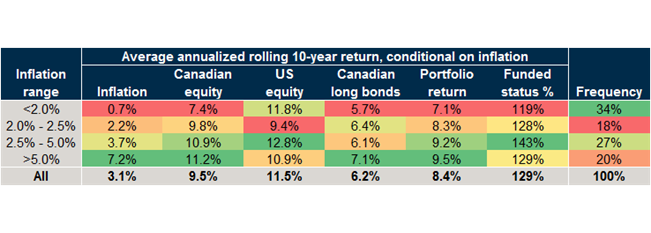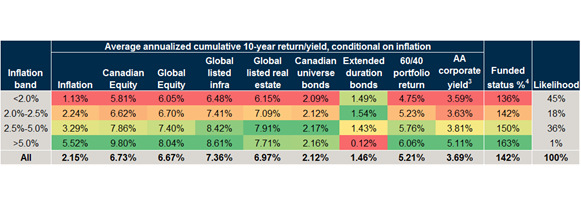Will high inflation hurt defined benefit plans? Probably not.
Inflation is all bad news, right? Gas prices spiking upwards, the accelerating prices of daily groceries, and don’t get me started on the red-hot housing market. But how might rising inflation impact defined benefit (DB) plans? Will our 30-year-high inflation numbers in Canada hurt a DB plan’s ability to close its funding gap? The answer is, probably not. In fact, if we focus primarily on a plan’s funded status, higher inflation could actually be good news.
Background on inflation, asset value, liability value and funded status
In markets, it is usually true that what is bad news for one investor is good news for another. And in the same way it is vital to manage a pension fund holistically, it is equally vital to view markets holistically. It is also vital to step back from today’s noise and look at how the current news compares to both the market cycles of the past and outlooks for the future.
Let’s examine today’s admittedly nerve-wracking inflation from the perspective of historical experience and from Russell Investments’ strategic capital markets forecasts. Setting aside the distinction between whether the currently high inflation is transitory or entrenched, but what might high inflation mean to asset class returns and what impact might it have on the funded status of DB plans?
While higher inflation presents immediate challenges to retirees in the form of reduced purchasing power—for basic needs such as gasoline, foods, and housing—we’ve observed that during extended periods of high inflation, asset class returns eventually catch up to and surpass inflation. Moreover, very few Canadian corporate DB plans provide guaranteed pension indexation, and assuming your plan does not provide indexation, higher inflation is associated with a higher effective discount rate/yield. Higher yield reduces the discounted present value of payments to current and future retirees (i.e., the liability value) and that leads to higher funded status. Measured in nominal dollars, the present value of the amount owed to members of a DB plan falls, while the amount earned on pension assets goes up. In other words, higher inflation is likely to lead to higher funded status and lower funding gaps- (assuming all other things equal).
Now, let’s take a look at different ranges of cumulative inflation over a 10-year horizon and the associated return to different asset classes, to the value of the DB liability and to the relevant funded status for each of those ranges.
Historical Perspective (using data and report published by the Canadian Institute of Actuaries, 1924 through 2020 inclusive)
Click image to enlarge

Source: Report on Canadian Economic Statistics 1924–2020, Canadian Institute of Actuaries, July 2021
For the table above, we used almost 100 years of inflation and market data. We measured cumulative inflation over rolling 10-year horizons for the period from 1924 to 2020. We then grouped those periods into four ranges of inflation shown in the first column. Within each inflation range, we then calculated the conditional average values of annualized cumulative returns to stocks, bonds, and to a 60/401 portfolio. Funded status is roughly estimated as the initial value (100%) times (1+CompoundPortfolioReturn)/(1+CompoundBondReturn).
The average overall inflation (for rolling 10-year horizons) was 3.1%, with average equity returns of 9.5% for Canadian and 11.5% for US. The average long bond return was 6.2% and the average funded status grew from 100% to 129%.
Now looking at the specific inflation ranges, Canadian equity and long bonds exhibited positive correlation with inflation while US equity returns seem less correlated. As a result, the portfolio returns and funded status ratios were generally positively correlated with inflation (i.e., portfolio return and funded status ratio would improve as inflation increases). Moreover, inflation was above 2.5% about 47% of the time.
Now, let’s examine the range of future possibilities of asset returns as well as funded status of an imaginary DB plan with a 60/402 asset mix, using Russell’s strategic capital markets forecasts.
Russell Investments’ forecasts as of 12/31/2021
Click image to enlarge
The table above shows statistics based on 5,000 stochastic trials drawn using Russell Investments’ most recent strategic capital markets forecast. Looking forward, the higher inflation ranges are associated with higher equity returns, but lower longer duration bond returns. Overall Canadian universe bonds seem to be less correlated with inflation as a result of mixed impact from raw yield and credit spreads.
That combination of higher equity returns and overall lower bond returns is the reason inflation can be good news for a DB plan’s funded status. Bond returns are depressed because yields are currently low, and as they rise (with higher inflation) the price decline depresses total return. At higher levels of inflation, the higher stock returns, lower bond (and liability) returns results in higher funded status.
The above observation does not work if your DB plan is mostly hedged against interest rate risk. In such case, the funded status volatility should be relatively low as asset and liability are expected to move closely (or even in tandem) when interest rate changes.
We’ve illustrated results on an accounting basis. Similar directional conclusions can be drawn from going concern and solvency perspective.
The bottom line
While there’s no dismissing the immediate pain to consumers and retirees associated with high inflation, there is a potential silver lining for DB plans. That said, inflation increases, rate increases and geopolitics simply add complexity to the already challenging job of institutional investing. In the midst of this complexity, make sure you choose a strategic partner who has the historic perspective, a holistic approach and the right set of capabilities to help you reach your desired outcome.
1Return seeking / liability hedging
2Return seeking / liability hedging
312-year high quality corporate bond yield
4Expected funded status % at the end of 10-year period
